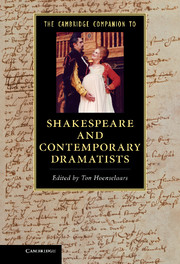Book contents
- Frontmatter
- Contents
- Illustrations
- Contributors
- Preface
- Chronology of the life and work of Shakespeare and contemporary dramatists
- 1 John Lyly and the University Wits
- 2 Thomas Kyd and the Elizabethan blockbuster
- 3 ‘The words of Mercury’
- 4 The dyer’s hand
- 5 Urbane John Marston
- 6 Thomas Dekker and the emergence of city comedy
- 7 Shakespeare
- 8 Thomas Heywood
- 9 George Chapman’s learned drama
- 10 Francis Beaumont and John Fletcher’s tragicomedy as musical melodrama
- 11 Thomas Middleton and the early modern theatre
- 12 John Webster
- 13 John Ford
- 14 Philip Massinger
- 15 Richard Brome and the idea of a Caroline theatre
- 16 Troublesome histories
- Select bibliography
- Index
- References
7 - Shakespeare
Colleagues, collaborators, co-authors
Published online by Cambridge University Press: 05 December 2012
- Frontmatter
- Contents
- Illustrations
- Contributors
- Preface
- Chronology of the life and work of Shakespeare and contemporary dramatists
- 1 John Lyly and the University Wits
- 2 Thomas Kyd and the Elizabethan blockbuster
- 3 ‘The words of Mercury’
- 4 The dyer’s hand
- 5 Urbane John Marston
- 6 Thomas Dekker and the emergence of city comedy
- 7 Shakespeare
- 8 Thomas Heywood
- 9 George Chapman’s learned drama
- 10 Francis Beaumont and John Fletcher’s tragicomedy as musical melodrama
- 11 Thomas Middleton and the early modern theatre
- 12 John Webster
- 13 John Ford
- 14 Philip Massinger
- 15 Richard Brome and the idea of a Caroline theatre
- 16 Troublesome histories
- Select bibliography
- Index
- References
Summary
With Shakespeare so firmly established on the Parnassian heights of world literature, some readers of his work still find it difficult to imagine that the dramatist’s plays were realised as part of a concentrated process of interaction with others, in a profession that was and remains ‘radically collaborative’. However, Shakespeare was never fully autonomous, the sole regulator or manager of the text’s meaning. Studying him we must not fail to acknowledge a broad range of contemporary cultural and historical determinants that together impacted on the creation and signification of that text, more or less beyond the reach of the author’s quill. As the plays were being written, but also as they were being performed, each time they negotiated realities including generic decorum, the specific material conditions of the stage and of the age, as government regulations and a series of conceptions of class, gender, race and religion were being redefined as part of a complex creative process. However, even if the early modern author, as Stephen Orgel put it, was ‘by no means at the center of the collaboration’, a reading of theatre history and culture can never entirely exclude the individuals, dramatists and collaborative playwrights who were continually redefining notions of dramatic authorship and engaged in realising these on the stages around the nation’s capital. As Jeffrey Knapp has argued more forcefully, ‘an institutional analysis of Renaissance drama can and indeed must keep authors squarely in the picture’.
Shakespeare had scores of colleagues and collaborated with many in the theatre and its periphery. Some of them contributed to bringing his plays to life at the Globe, the Blackfriars playhouse, or at court – including the actors on stage, the backstage crew and the audience in the auditorium, and occasionally also on the stage. Others, too, including the scribes, bookkeepers, censors and printers, have contributed to shaping the appearance of the Shakespearean texts we read and see performed today. Their impact may be different in kind and consequence, but it must not be ignored.
- Type
- Chapter
- Information
- Publisher: Cambridge University PressPrint publication year: 2012
References
- 1
- Cited by

